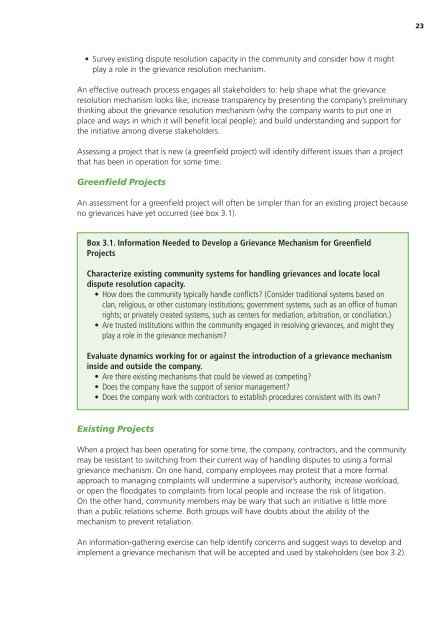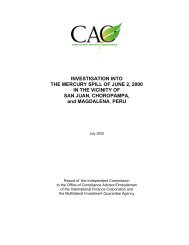A Guide to Designing and Implementing Grievance Mechanisms for ...
A Guide to Designing and Implementing Grievance Mechanisms for ...
A Guide to Designing and Implementing Grievance Mechanisms for ...
Create successful ePaper yourself
Turn your PDF publications into a flip-book with our unique Google optimized e-Paper software.
• Survey existing dispute resolution capacity in the community <strong>and</strong> consider how it might<br />
play a role in the grievance resolution mechanism.<br />
An effective outreach process engages all stakeholders <strong>to</strong>: help shape what the grievance<br />
resolution mechanism looks like; increase transparency by presenting the company’s preliminary<br />
thinking about the grievance resolution mechanism (why the company wants <strong>to</strong> put one in<br />
place <strong>and</strong> ways in which it will benefit local people); <strong>and</strong> build underst<strong>and</strong>ing <strong>and</strong> support <strong>for</strong><br />
the initiative among diverse stakeholders.<br />
Assessing a project that is new (a greenfield project) will identify different issues than a project<br />
that has been in operation <strong>for</strong> some time.<br />
Greenfield Projects<br />
An assessment <strong>for</strong> a greenfield project will often be simpler than <strong>for</strong> an existing project because<br />
no grievances have yet occurred (see box 3.1).<br />
Box 3.1. In<strong>for</strong>mation Needed <strong>to</strong> Develop a <strong>Grievance</strong> Mechanism <strong>for</strong> Greenfield<br />
Projects<br />
Characterize existing community systems <strong>for</strong> h<strong>and</strong>ling grievances <strong>and</strong> locate local<br />
dispute resolution capacity.<br />
• How does the community typically h<strong>and</strong>le conflicts? (Consider traditional systems based on<br />
clan, religious, or other cus<strong>to</strong>mary institutions; government systems, such as an office of human<br />
rights; or privately created systems, such as centers <strong>for</strong> mediation, arbitration, or conciliation.)<br />
• Are trusted institutions within the community engaged in resolving grievances, <strong>and</strong> might they<br />
play a role in the grievance mechanism?<br />
Evaluate dynamics working <strong>for</strong> or against the introduction of a grievance mechanism<br />
inside <strong>and</strong> outside the company.<br />
• Are there existing mechanisms that could be viewed as competing?<br />
• Does the company have the support of senior management?<br />
• Does the company work with contrac<strong>to</strong>rs <strong>to</strong> establish procedures consistent with its own?<br />
Existing Projects<br />
When a project has been operating <strong>for</strong> some time, the company, contrac<strong>to</strong>rs, <strong>and</strong> the community<br />
may be resistant <strong>to</strong> switching from their current way of h<strong>and</strong>ling disputes <strong>to</strong> using a <strong>for</strong>mal<br />
grievance mechanism. On one h<strong>and</strong>, company employees may protest that a more <strong>for</strong>mal<br />
approach <strong>to</strong> managing complaints will undermine a supervisor’s authority, increase workload,<br />
or open the floodgates <strong>to</strong> complaints from local people <strong>and</strong> increase the risk of litigation.<br />
On the other h<strong>and</strong>, community members may be wary that such an initiative is little more<br />
than a public relations scheme. Both groups will have doubts about the ability of the<br />
mechanism <strong>to</strong> prevent retaliation.<br />
An in<strong>for</strong>mation-gathering exercise can help identify concerns <strong>and</strong> suggest ways <strong>to</strong> develop <strong>and</strong><br />
implement a grievance mechanism that will be accepted <strong>and</strong> used by stakeholders (see box 3.2).<br />
23





